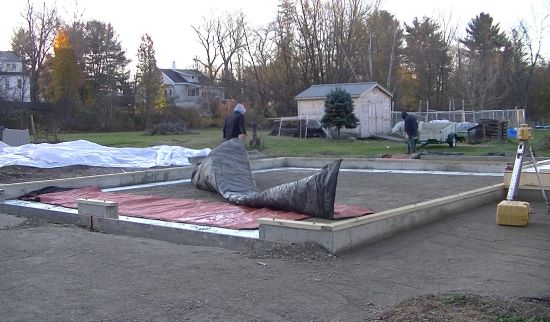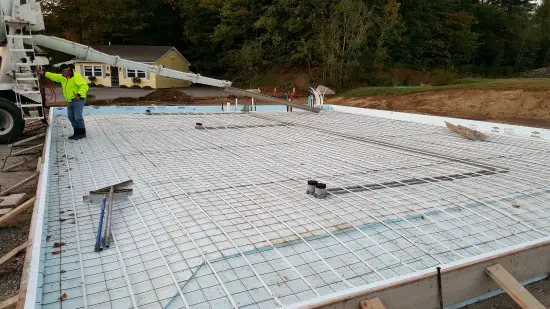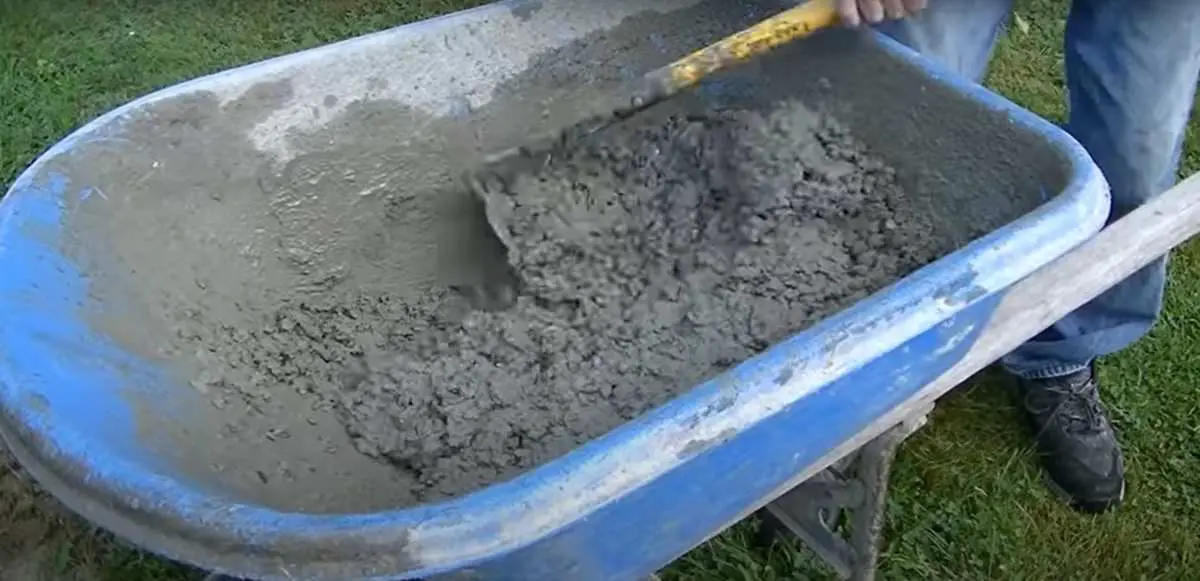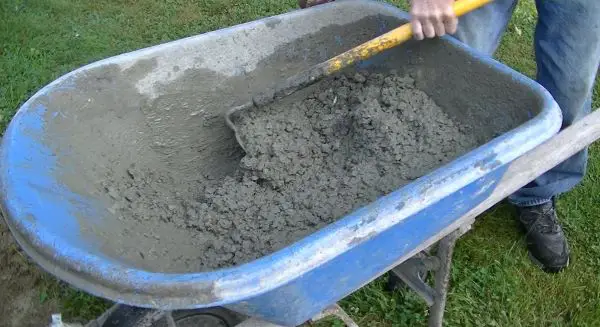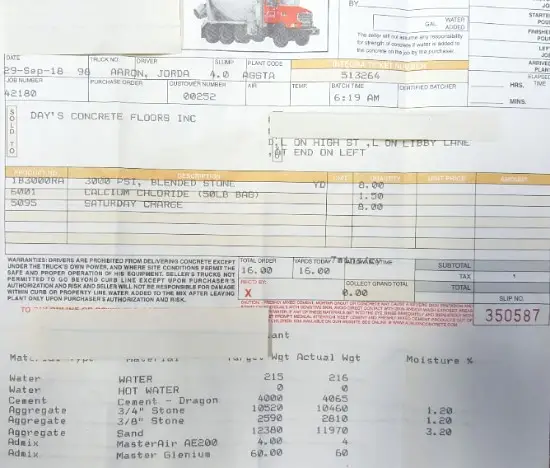Cold Weather Concrete
What happens to concrete when temperatures are below freezing?
Hello everyone, my name is Mike Day and I am the owner of Day's Concrete Floors, located in Maine. I experience brutally cold weather for about 5 out of 12 months a year here. However, the show must go on.
Being from Maine, our cold weather concreting season is from late October until sometime in March. So, if you're wondering if pouring concrete is possible in cold weather- the answer is YES.
Having to make a living pouring concrete floors during Maine winters since the 1980's, I've learned a lot about what happens to fresh concrete if it's exposed to cold and freezing temperatures.
One thing I know for sure, if you let newly poured concrete freeze, you will have issues with the surface scaling, pop-outs, cracking, and overall weaker concrete.
Let me teach you the right way to pour concrete in cold weather.
We covered the slab below with insulating blankets, a layer of hay, and a tarp over everything after we were done troweling.
The air temperatures for the next four days were all below freezing but the slab temperature under the blankets four days after the pour was 70 degrees F.
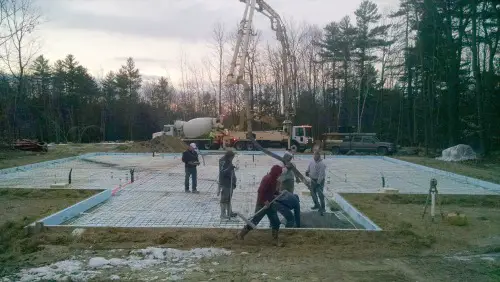 It was 20 degrees F when we started this pour It was 20 degrees F when we started this pour |
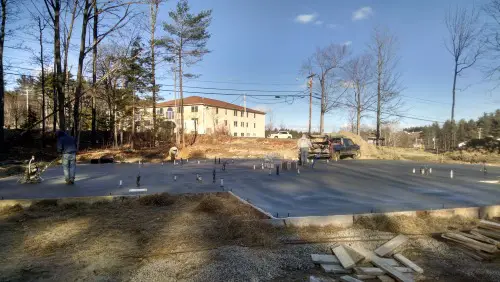 The temp. reached a high of 33 degrees F and the concrete dried just fine The temp. reached a high of 33 degrees F and the concrete dried just fine |
I highly recommend the insulating blankets like the one's we're using below to protect your concrete slabs, floors, and foundation wall pours.
You can buy them 6' x 25' or 12' x 25'. I can vouch for them, THEY WORK!
You can get them right on Amazon and have them shipped right to you.
Buy your insulating blankets here.
I've had concrete floors where the entire surface has peeled off (top 1/8") because the general contractor refused to protect and insulate the concrete after we troweled it and the temperature dropped into the 20's overnight.
How to keep the concrete from freezing
FIRST LET'S STATE THE OBVIOUS
NEVER pour on frozen ground, Never! Sorry, just wanted to make that clear.
In cold weather, especially temperatures below freezing, the concrete mix should be batched with warm or hot water.
Generally speaking, water temps between 120 - 140 degrees F will give you a concrete temperature around 60 - 70 degrees after it's mixed in the concrete truck.
I'm speaking from my own experience, actually checking the temperature of concrete mixtures when the concrete truck shows up on my job-site.
Forms, rebar, and embedded bond-outs should all be clear of snow and ice before pouring or you'll have voids in those places.
After the concrete is placed, building enclosures, portable heaters, and insulated blankets should be ready to maintain the concrete temperature.
If the air temperatures are in the 30's F or below and the ready-mix company isn't using warm/hot water to batch the concrete, I would seriously think twice about pouring concrete that day.
Did you know this about cold weather concrete?
- Fresh or Plastic concrete will freeze if the temperature falls below 25 degrees F (-4C).
- Concrete gains very little early strength at low temperatures.
- Freshly mixed concrete must be protected against freezing until it reaches a compressive strength of 500 psi.
- At normal temperatures (70 degrees F) concrete usually reaches 500 psi in the first 24 hours.
- At 40 degrees F concrete could take up to 3 days to reach 500 psi.
- Significant overall reductions in strength gain, up to 50%, can occur if concrete is frozen before it reaches 500 psi.
- Concrete that goes through just one freeze cycle before reaching 500 psi may be restored to nearly normal strength if proper insulating/curing is done.
- Fresh concrete that freezes will not be as weather resistant or water-tight as concrete that hasn't been frozen.
- Air-entrained concrete is less susceptible to early freezing than non-air-entrained concrete.
- Low temperatures greatly slow the rate at which hydration of cement occurs which ultimately slows the hardening and strength gain of the concrete.
CONCRETE GENERATES HEAT as it cures early on
Once the dry ingredients (cement, sand, aggregate) are mixed with water a chemical process takes place between the cement and water where they form a paste.
The heat generated from this process is called heat of hydration.
The amount of heat generated is affected by:
- the type of cement used
- amount of cement in the mix
- thickness of the concrete
- air temperature
- initial concrete temperature
- water-cement ratio
- how fine or course the cement is made
- any admixtures used
Heat of hydration is very important when pouring concrete in the winter.
Often the heat from hydration along with covering the concrete with curing or insulating blankets is enough to cure the concrete and keep it from freezing.
TO USE OR NOT TO USE AIR-ENTRAINED CONCRETE
In most cases, exterior cold weather concreting should include an air-entraining admixture.
Entrained air is most important when concrete is placed in freezing weather.
Why, because air entrainment provides concrete the capacity to absorb stresses due to ice formation within the mix.
Here's my simple explanation of air-entrainment in concrete!
Picture what Dawn dish detergent does when you put it in the water to wash dishes. It bubbles up like crazy, right.
Those bubbles are kind of what air-entrainment is in concrete.
Thousands of microscopic air bubbles in the mix that allow concrete to absorb water and give the water room to expand when it freezes.
Since there's voids for the water to expand, there's usually little or no damage done to the concrete.
You know there's a pretty good chance new concrete placed in the winter will see some rain, snow, or ice. Without any air entrainment, if the concrete freezes after being saturated with some form of water, it will lose strength.
The results might not be seen until the concrete thaws, but will likely
lead to some form of scaling or pitting on the surface.
POURING CONCRETE ON THE GROUND IN COLD WEATHER
Whether your pouring concrete footings, floors, or slabs, the ground can't be frozen.
You'll have to protect the sub-grade with insulating blankets, hay, or tent the area and heat it before the pour.
A cold sub-grade will suck the heat right out of the concrete, retarding the set time dramatically.
If you tent and heat the area with a direct-fired heater like a kerosene torpedo heater, you must vent the heater to the outside air. This type of heater produces CO2 (carbon dioxide) that will combine with calcium hydroxide on the surface of fresh concrete to form a weak layer of calcium carbonate that interferes with cement hydration.
In short, just make sure fresh air is coming in through the back of the heater.
Plan, well in advance, on how you're going to protect the concrete after the pour. Have everything you'll need, blankets, hay, tarps, heaters on site and ready as soon as you need to cover the concrete.
The sooner you protect the concrete from freezing the more heat from hydration you'll save.
POURING CONCRETE ABOVE GROUND IN COLD OR FREEZING TEMPERATURES
When pouring on some type of decking it's a good idea to enclose the area below the pour and heat the underside of the metal or wood decking.
Heat the underside area at least a day in advance to warm the decking and melt any frost, snow, or ice on the deck above.
After the concrete is finish troweled, lay some insulating blankets on top of the slab to keep it from freezing. Make sure to weigh the blankets down so the wind doesn't blow them off, 2x4's or rebar works good.
Check out the video below to learn more about pouring and finishing concrete when it is cold:
Take a look at my 9 things to consider before pouring concrete in cold weather.
Also, can concrete be poured in the winter safely?
These are the same insulating blankets we use to keep our concrete floors, slabs, and walls from freezing in cold weather.
They're available right from Amazon or if you have a local concrete supply store near you, they should have them also.
Disclaimer: I am an affiliate of Amazon, if you purchase them through my link, I will receive a small commission. Thank you.
what i wear to pour concrete in cold weather
Here is a list of clothing items I wear to stay warm while pouring concrete in freezing temperatures:
If you'd like to learn more about concrete, check out the CONCRETE UNDERGROUND
Mike
